Report on Implementing, Monitoring, and Evaluating Nursing Care Plans
VerifiedAdded on 2020/10/04
|13
|3140
|168
Report
AI Summary
This report delves into the critical aspects of nursing care plans, encompassing implementation, monitoring, and evaluation strategies. It addresses various scenarios, including patient comfort, activities of daily living (ADLs), and specific conditions like hemiplegia, osteoarthritis, and Parkinson's disease. The report explores interventions such as personal hygiene, pressure injury prevention, and the use of assistive devices. It also discusses behavioral, pharmacologic, and mechanical techniques for managing urinary incontinence and provides insights into resuscitation, asthma management, and nursing interventions for complications like pressure injuries, constipation, and cognitive decline. The importance of clinical handovers, medication administration, and the prevention of adverse effects are also highlighted, offering a comprehensive overview of effective nursing practices. This report is a valuable resource for healthcare professionals and students seeking to enhance their understanding of patient care and improve outcomes.

Implement, monitor and
evaluate nursing care plans
evaluate nursing care plans
Paraphrase This Document
Need a fresh take? Get an instant paraphrase of this document with our AI Paraphraser

Table of Contents
INTRODUCTION...........................................................................................................................1
1.1...........................................................................................................................................1
1.2...........................................................................................................................................1
2.1...........................................................................................................................................1
2.2...........................................................................................................................................1
3.1...........................................................................................................................................2
3.2...........................................................................................................................................2
3.3...........................................................................................................................................2
3.4...........................................................................................................................................2
4.1...........................................................................................................................................2
4.2...........................................................................................................................................2
5.1...........................................................................................................................................3
5.2...........................................................................................................................................3
5.3...........................................................................................................................................3
5.4...........................................................................................................................................3
5.5...........................................................................................................................................3
5.6...........................................................................................................................................3
5.7...........................................................................................................................................4
5.8...........................................................................................................................................4
5.9...........................................................................................................................................4
6.1...........................................................................................................................................4
6.2...........................................................................................................................................4
6.3...........................................................................................................................................4
7.1...........................................................................................................................................5
7.2...........................................................................................................................................5
8.1...........................................................................................................................................5
9.9...........................................................................................................................................5
9.2...........................................................................................................................................6
9.3...........................................................................................................................................6
10.1.........................................................................................................................................6
INTRODUCTION...........................................................................................................................1
1.1...........................................................................................................................................1
1.2...........................................................................................................................................1
2.1...........................................................................................................................................1
2.2...........................................................................................................................................1
3.1...........................................................................................................................................2
3.2...........................................................................................................................................2
3.3...........................................................................................................................................2
3.4...........................................................................................................................................2
4.1...........................................................................................................................................2
4.2...........................................................................................................................................2
5.1...........................................................................................................................................3
5.2...........................................................................................................................................3
5.3...........................................................................................................................................3
5.4...........................................................................................................................................3
5.5...........................................................................................................................................3
5.6...........................................................................................................................................3
5.7...........................................................................................................................................4
5.8...........................................................................................................................................4
5.9...........................................................................................................................................4
6.1...........................................................................................................................................4
6.2...........................................................................................................................................4
6.3...........................................................................................................................................4
7.1...........................................................................................................................................5
7.2...........................................................................................................................................5
8.1...........................................................................................................................................5
9.9...........................................................................................................................................5
9.2...........................................................................................................................................6
9.3...........................................................................................................................................6
10.1.........................................................................................................................................6
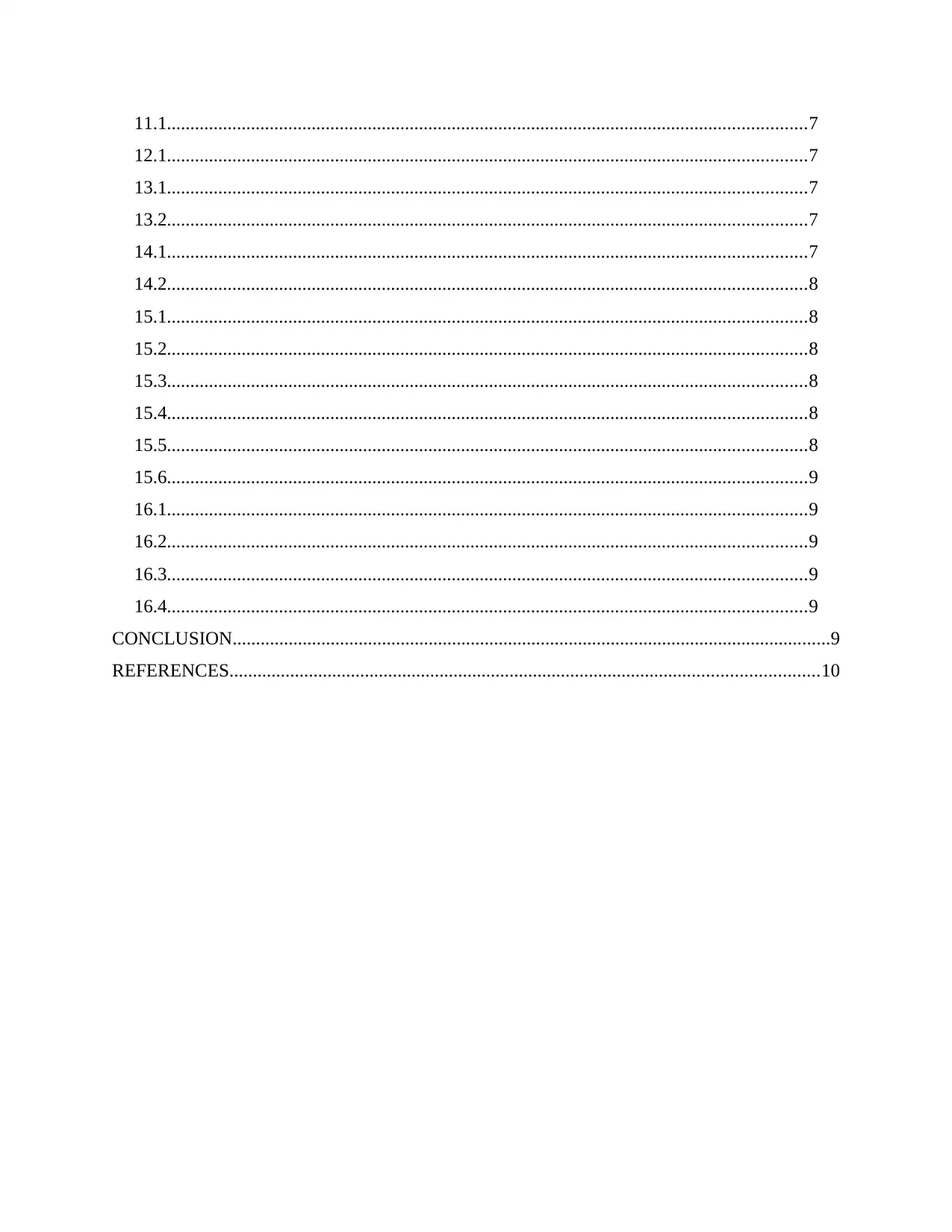
11.1.........................................................................................................................................7
12.1.........................................................................................................................................7
13.1.........................................................................................................................................7
13.2.........................................................................................................................................7
14.1.........................................................................................................................................7
14.2.........................................................................................................................................8
15.1.........................................................................................................................................8
15.2.........................................................................................................................................8
15.3.........................................................................................................................................8
15.4.........................................................................................................................................8
15.5.........................................................................................................................................8
15.6.........................................................................................................................................9
16.1.........................................................................................................................................9
16.2.........................................................................................................................................9
16.3.........................................................................................................................................9
16.4.........................................................................................................................................9
CONCLUSION................................................................................................................................9
REFERENCES..............................................................................................................................10
12.1.........................................................................................................................................7
13.1.........................................................................................................................................7
13.2.........................................................................................................................................7
14.1.........................................................................................................................................7
14.2.........................................................................................................................................8
15.1.........................................................................................................................................8
15.2.........................................................................................................................................8
15.3.........................................................................................................................................8
15.4.........................................................................................................................................8
15.5.........................................................................................................................................8
15.6.........................................................................................................................................9
16.1.........................................................................................................................................9
16.2.........................................................................................................................................9
16.3.........................................................................................................................................9
16.4.........................................................................................................................................9
CONCLUSION................................................................................................................................9
REFERENCES..............................................................................................................................10
⊘ This is a preview!⊘
Do you want full access?
Subscribe today to unlock all pages.

Trusted by 1+ million students worldwide
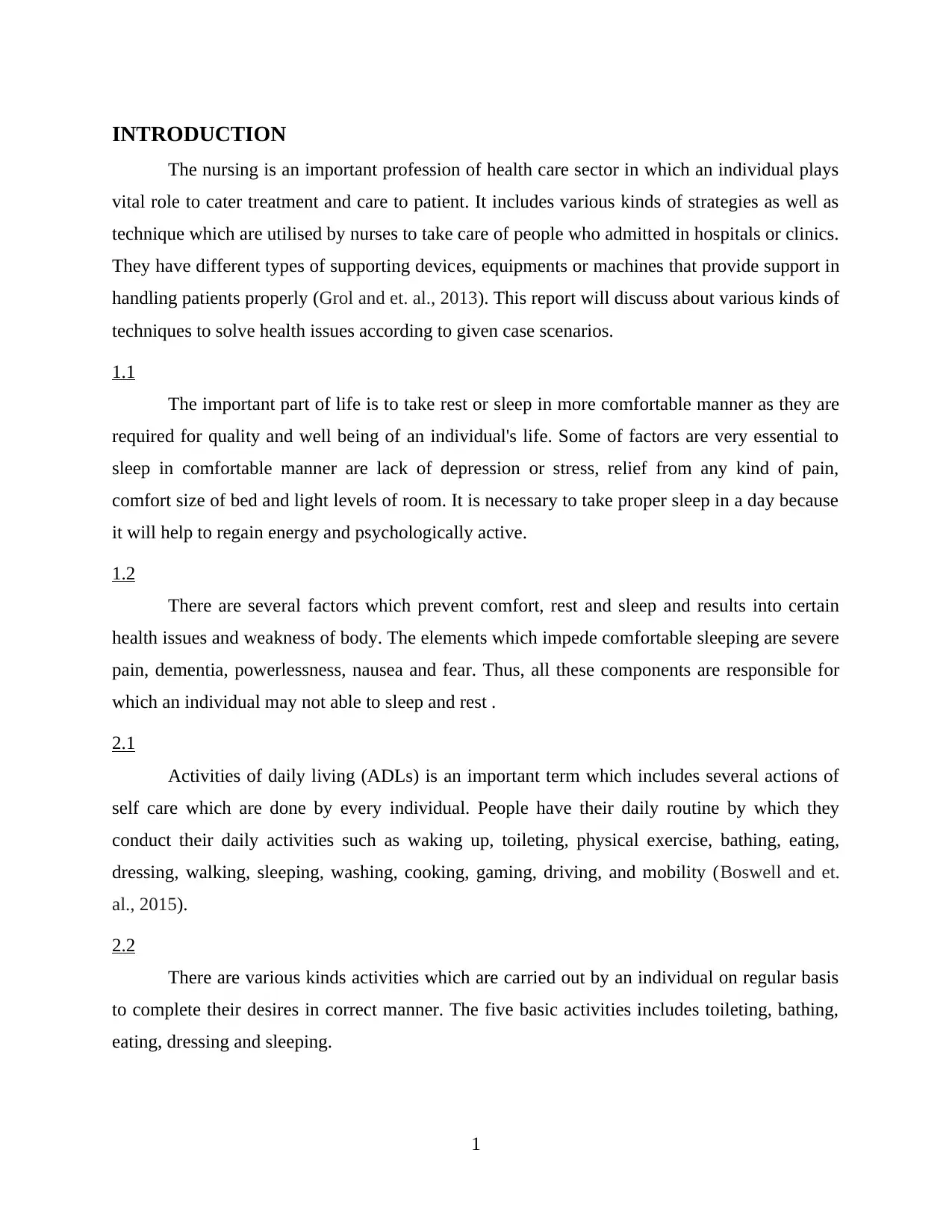
INTRODUCTION
The nursing is an important profession of health care sector in which an individual plays
vital role to cater treatment and care to patient. It includes various kinds of strategies as well as
technique which are utilised by nurses to take care of people who admitted in hospitals or clinics.
They have different types of supporting devices, equipments or machines that provide support in
handling patients properly (Grol and et. al., 2013). This report will discuss about various kinds of
techniques to solve health issues according to given case scenarios.
1.1
The important part of life is to take rest or sleep in more comfortable manner as they are
required for quality and well being of an individual's life. Some of factors are very essential to
sleep in comfortable manner are lack of depression or stress, relief from any kind of pain,
comfort size of bed and light levels of room. It is necessary to take proper sleep in a day because
it will help to regain energy and psychologically active.
1.2
There are several factors which prevent comfort, rest and sleep and results into certain
health issues and weakness of body. The elements which impede comfortable sleeping are severe
pain, dementia, powerlessness, nausea and fear. Thus, all these components are responsible for
which an individual may not able to sleep and rest .
2.1
Activities of daily living (ADLs) is an important term which includes several actions of
self care which are done by every individual. People have their daily routine by which they
conduct their daily activities such as waking up, toileting, physical exercise, bathing, eating,
dressing, walking, sleeping, washing, cooking, gaming, driving, and mobility (Boswell and et.
al., 2015).
2.2
There are various kinds activities which are carried out by an individual on regular basis
to complete their desires in correct manner. The five basic activities includes toileting, bathing,
eating, dressing and sleeping.
1
The nursing is an important profession of health care sector in which an individual plays
vital role to cater treatment and care to patient. It includes various kinds of strategies as well as
technique which are utilised by nurses to take care of people who admitted in hospitals or clinics.
They have different types of supporting devices, equipments or machines that provide support in
handling patients properly (Grol and et. al., 2013). This report will discuss about various kinds of
techniques to solve health issues according to given case scenarios.
1.1
The important part of life is to take rest or sleep in more comfortable manner as they are
required for quality and well being of an individual's life. Some of factors are very essential to
sleep in comfortable manner are lack of depression or stress, relief from any kind of pain,
comfort size of bed and light levels of room. It is necessary to take proper sleep in a day because
it will help to regain energy and psychologically active.
1.2
There are several factors which prevent comfort, rest and sleep and results into certain
health issues and weakness of body. The elements which impede comfortable sleeping are severe
pain, dementia, powerlessness, nausea and fear. Thus, all these components are responsible for
which an individual may not able to sleep and rest .
2.1
Activities of daily living (ADLs) is an important term which includes several actions of
self care which are done by every individual. People have their daily routine by which they
conduct their daily activities such as waking up, toileting, physical exercise, bathing, eating,
dressing, walking, sleeping, washing, cooking, gaming, driving, and mobility (Boswell and et.
al., 2015).
2.2
There are various kinds activities which are carried out by an individual on regular basis
to complete their desires in correct manner. The five basic activities includes toileting, bathing,
eating, dressing and sleeping.
1
Paraphrase This Document
Need a fresh take? Get an instant paraphrase of this document with our AI Paraphraser

3.1
A person suffering from right sided hemiplegia lost their ability to move the affected part
of body then it is very difficult to wear clothes. In case of wearing shirt, they have to choose shirt
that fit loosely and replace buttons from Velcro. It is necessary to help client to be in a
comfortable position and then provide assistance in putting on clothes.
3.2
The chronic osteoarthritis includes problems in joints in which cartilage break downs,
causing pains, swelling and problems moving joint properly. As per given condition, a patient
has the same issue in wrist and knuckles due to which several problems are created to take meal
on daily basis (Chisholm-Burns, Wells and Schwinghammer, 2016). Thus, electric can openers,
food processors and mandolins along with arthritis gadgets to make feeding easy.
3.3
According to given scenario, a person has Parkinson' s diseases in which loss of
automatic movements, imbalance, tremors, rigid muscles are observed. As per given case, a
client needs to get up from bed and stand then it is necessary to use assistive devices like straight
canes or four-wheeled walkers.
3.4
According to situation of given scenario, an old person become weak and do not capable
to conduct several activities without any help such as walking, standing and moving. There are
certain aids which can be used to walk by himself such as four-wheeled walkers, electronic
wheel chairs etc.
4.1
The personal hygiene refers to cleaning of body and foot care so that germs will not
spread whereas grooming include taking care of cleanliness of nails and hairs. Purpose of
maintaining hygiene and grooming involves several factors such as improve body image, social
reasons, reducing health issues and psychological problems (Gulanick and Myers, 2013).
4.2
A pressure injury refers to localise damage to skin or soft underlying tissue related to
medical care which occurs due to combination of pressure with shear. There are several
contributing factors such as friction, shear, advanced age and nutrition.
2
A person suffering from right sided hemiplegia lost their ability to move the affected part
of body then it is very difficult to wear clothes. In case of wearing shirt, they have to choose shirt
that fit loosely and replace buttons from Velcro. It is necessary to help client to be in a
comfortable position and then provide assistance in putting on clothes.
3.2
The chronic osteoarthritis includes problems in joints in which cartilage break downs,
causing pains, swelling and problems moving joint properly. As per given condition, a patient
has the same issue in wrist and knuckles due to which several problems are created to take meal
on daily basis (Chisholm-Burns, Wells and Schwinghammer, 2016). Thus, electric can openers,
food processors and mandolins along with arthritis gadgets to make feeding easy.
3.3
According to given scenario, a person has Parkinson' s diseases in which loss of
automatic movements, imbalance, tremors, rigid muscles are observed. As per given case, a
client needs to get up from bed and stand then it is necessary to use assistive devices like straight
canes or four-wheeled walkers.
3.4
According to situation of given scenario, an old person become weak and do not capable
to conduct several activities without any help such as walking, standing and moving. There are
certain aids which can be used to walk by himself such as four-wheeled walkers, electronic
wheel chairs etc.
4.1
The personal hygiene refers to cleaning of body and foot care so that germs will not
spread whereas grooming include taking care of cleanliness of nails and hairs. Purpose of
maintaining hygiene and grooming involves several factors such as improve body image, social
reasons, reducing health issues and psychological problems (Gulanick and Myers, 2013).
4.2
A pressure injury refers to localise damage to skin or soft underlying tissue related to
medical care which occurs due to combination of pressure with shear. There are several
contributing factors such as friction, shear, advanced age and nutrition.
2
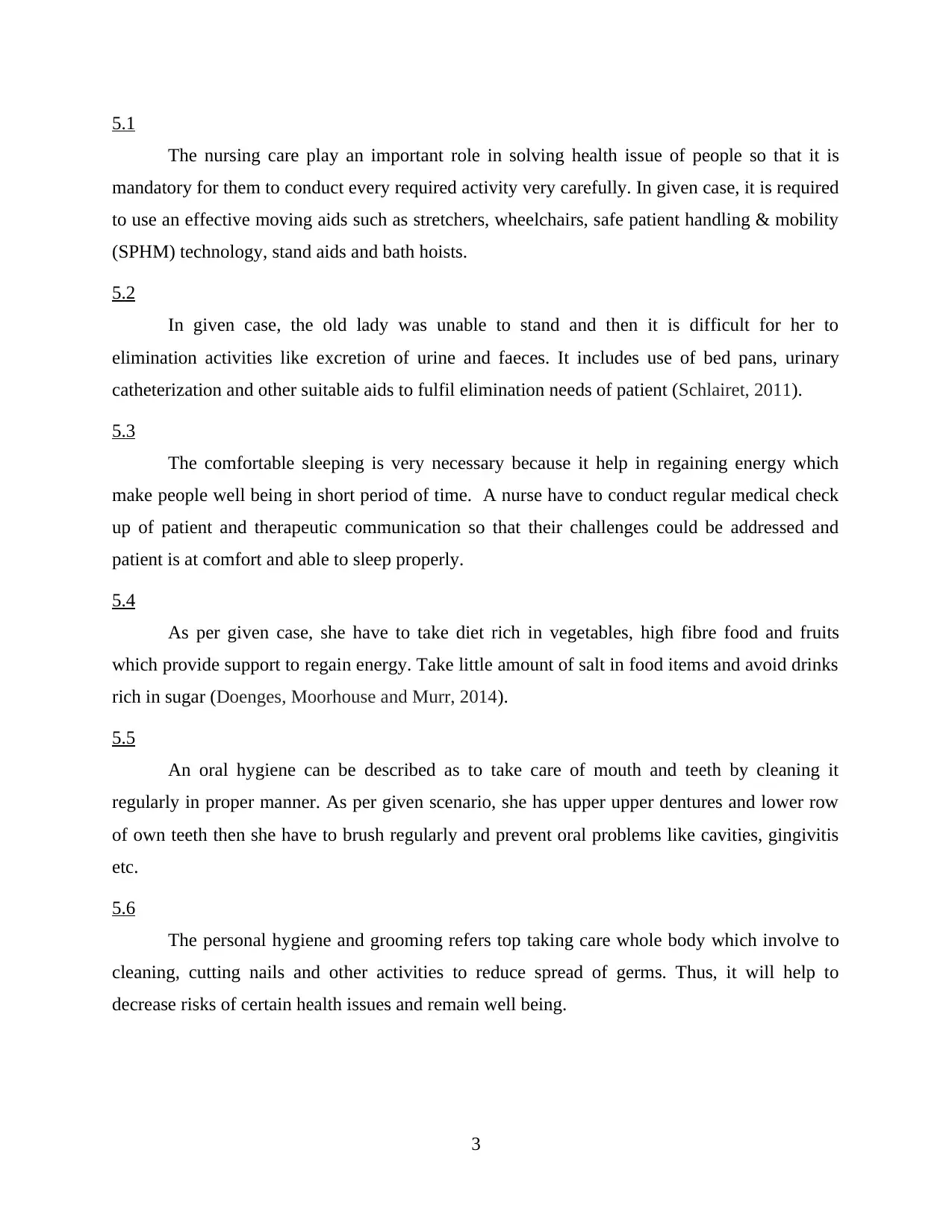
5.1
The nursing care play an important role in solving health issue of people so that it is
mandatory for them to conduct every required activity very carefully. In given case, it is required
to use an effective moving aids such as stretchers, wheelchairs, safe patient handling & mobility
(SPHM) technology, stand aids and bath hoists.
5.2
In given case, the old lady was unable to stand and then it is difficult for her to
elimination activities like excretion of urine and faeces. It includes use of bed pans, urinary
catheterization and other suitable aids to fulfil elimination needs of patient (Schlairet, 2011).
5.3
The comfortable sleeping is very necessary because it help in regaining energy which
make people well being in short period of time. A nurse have to conduct regular medical check
up of patient and therapeutic communication so that their challenges could be addressed and
patient is at comfort and able to sleep properly.
5.4
As per given case, she have to take diet rich in vegetables, high fibre food and fruits
which provide support to regain energy. Take little amount of salt in food items and avoid drinks
rich in sugar (Doenges, Moorhouse and Murr, 2014).
5.5
An oral hygiene can be described as to take care of mouth and teeth by cleaning it
regularly in proper manner. As per given scenario, she has upper upper dentures and lower row
of own teeth then she have to brush regularly and prevent oral problems like cavities, gingivitis
etc.
5.6
The personal hygiene and grooming refers top taking care whole body which involve to
cleaning, cutting nails and other activities to reduce spread of germs. Thus, it will help to
decrease risks of certain health issues and remain well being.
3
The nursing care play an important role in solving health issue of people so that it is
mandatory for them to conduct every required activity very carefully. In given case, it is required
to use an effective moving aids such as stretchers, wheelchairs, safe patient handling & mobility
(SPHM) technology, stand aids and bath hoists.
5.2
In given case, the old lady was unable to stand and then it is difficult for her to
elimination activities like excretion of urine and faeces. It includes use of bed pans, urinary
catheterization and other suitable aids to fulfil elimination needs of patient (Schlairet, 2011).
5.3
The comfortable sleeping is very necessary because it help in regaining energy which
make people well being in short period of time. A nurse have to conduct regular medical check
up of patient and therapeutic communication so that their challenges could be addressed and
patient is at comfort and able to sleep properly.
5.4
As per given case, she have to take diet rich in vegetables, high fibre food and fruits
which provide support to regain energy. Take little amount of salt in food items and avoid drinks
rich in sugar (Doenges, Moorhouse and Murr, 2014).
5.5
An oral hygiene can be described as to take care of mouth and teeth by cleaning it
regularly in proper manner. As per given scenario, she has upper upper dentures and lower row
of own teeth then she have to brush regularly and prevent oral problems like cavities, gingivitis
etc.
5.6
The personal hygiene and grooming refers top taking care whole body which involve to
cleaning, cutting nails and other activities to reduce spread of germs. Thus, it will help to
decrease risks of certain health issues and remain well being.
3
⊘ This is a preview!⊘
Do you want full access?
Subscribe today to unlock all pages.

Trusted by 1+ million students worldwide
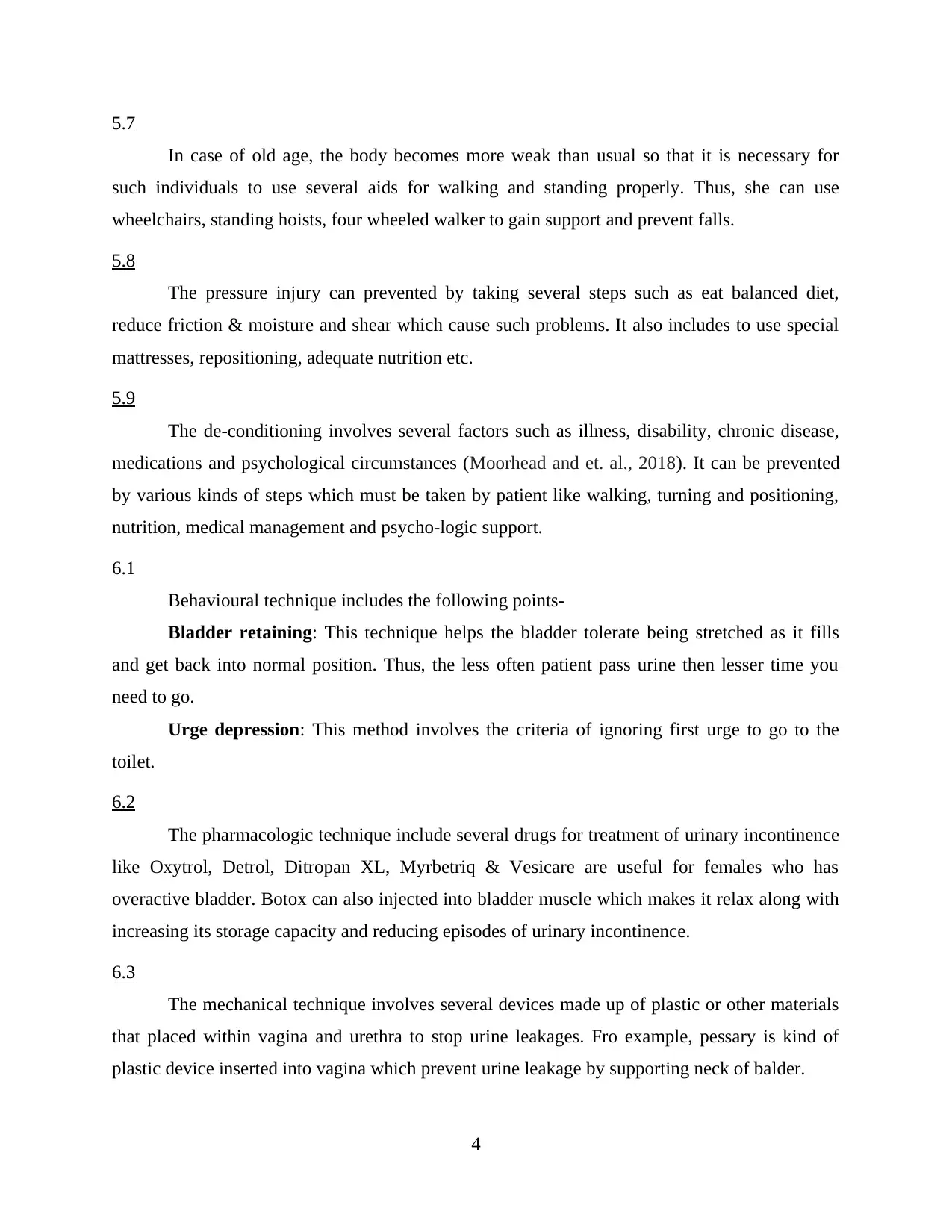
5.7
In case of old age, the body becomes more weak than usual so that it is necessary for
such individuals to use several aids for walking and standing properly. Thus, she can use
wheelchairs, standing hoists, four wheeled walker to gain support and prevent falls.
5.8
The pressure injury can prevented by taking several steps such as eat balanced diet,
reduce friction & moisture and shear which cause such problems. It also includes to use special
mattresses, repositioning, adequate nutrition etc.
5.9
The de-conditioning involves several factors such as illness, disability, chronic disease,
medications and psychological circumstances (Moorhead and et. al., 2018). It can be prevented
by various kinds of steps which must be taken by patient like walking, turning and positioning,
nutrition, medical management and psycho-logic support.
6.1
Behavioural technique includes the following points-
Bladder retaining: This technique helps the bladder tolerate being stretched as it fills
and get back into normal position. Thus, the less often patient pass urine then lesser time you
need to go.
Urge depression: This method involves the criteria of ignoring first urge to go to the
toilet.
6.2
The pharmacologic technique include several drugs for treatment of urinary incontinence
like Oxytrol, Detrol, Ditropan XL, Myrbetriq & Vesicare are useful for females who has
overactive bladder. Botox can also injected into bladder muscle which makes it relax along with
increasing its storage capacity and reducing episodes of urinary incontinence.
6.3
The mechanical technique involves several devices made up of plastic or other materials
that placed within vagina and urethra to stop urine leakages. Fro example, pessary is kind of
plastic device inserted into vagina which prevent urine leakage by supporting neck of balder.
4
In case of old age, the body becomes more weak than usual so that it is necessary for
such individuals to use several aids for walking and standing properly. Thus, she can use
wheelchairs, standing hoists, four wheeled walker to gain support and prevent falls.
5.8
The pressure injury can prevented by taking several steps such as eat balanced diet,
reduce friction & moisture and shear which cause such problems. It also includes to use special
mattresses, repositioning, adequate nutrition etc.
5.9
The de-conditioning involves several factors such as illness, disability, chronic disease,
medications and psychological circumstances (Moorhead and et. al., 2018). It can be prevented
by various kinds of steps which must be taken by patient like walking, turning and positioning,
nutrition, medical management and psycho-logic support.
6.1
Behavioural technique includes the following points-
Bladder retaining: This technique helps the bladder tolerate being stretched as it fills
and get back into normal position. Thus, the less often patient pass urine then lesser time you
need to go.
Urge depression: This method involves the criteria of ignoring first urge to go to the
toilet.
6.2
The pharmacologic technique include several drugs for treatment of urinary incontinence
like Oxytrol, Detrol, Ditropan XL, Myrbetriq & Vesicare are useful for females who has
overactive bladder. Botox can also injected into bladder muscle which makes it relax along with
increasing its storage capacity and reducing episodes of urinary incontinence.
6.3
The mechanical technique involves several devices made up of plastic or other materials
that placed within vagina and urethra to stop urine leakages. Fro example, pessary is kind of
plastic device inserted into vagina which prevent urine leakage by supporting neck of balder.
4
Paraphrase This Document
Need a fresh take? Get an instant paraphrase of this document with our AI Paraphraser
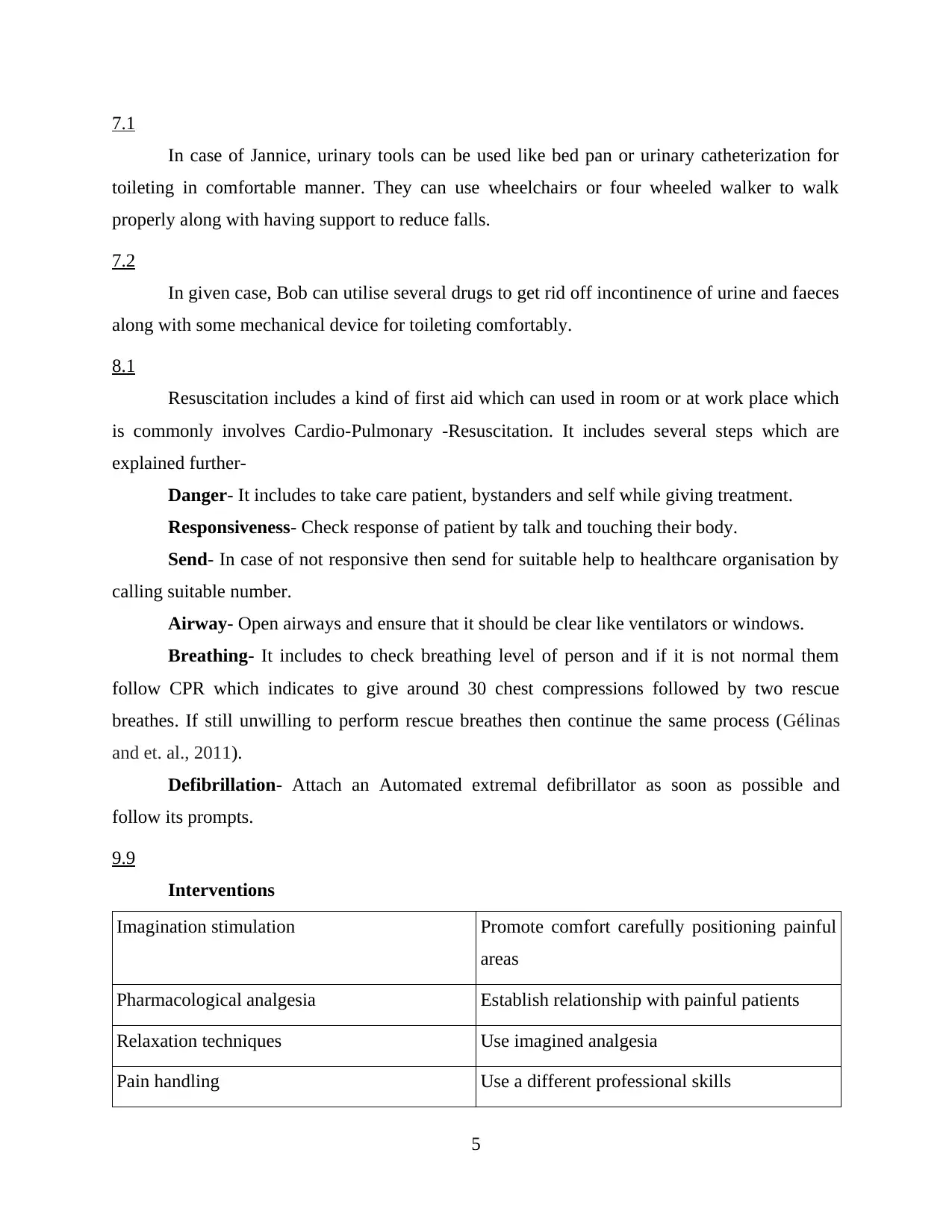
7.1
In case of Jannice, urinary tools can be used like bed pan or urinary catheterization for
toileting in comfortable manner. They can use wheelchairs or four wheeled walker to walk
properly along with having support to reduce falls.
7.2
In given case, Bob can utilise several drugs to get rid off incontinence of urine and faeces
along with some mechanical device for toileting comfortably.
8.1
Resuscitation includes a kind of first aid which can used in room or at work place which
is commonly involves Cardio-Pulmonary -Resuscitation. It includes several steps which are
explained further-
Danger- It includes to take care patient, bystanders and self while giving treatment.
Responsiveness- Check response of patient by talk and touching their body.
Send- In case of not responsive then send for suitable help to healthcare organisation by
calling suitable number.
Airway- Open airways and ensure that it should be clear like ventilators or windows.
Breathing- It includes to check breathing level of person and if it is not normal them
follow CPR which indicates to give around 30 chest compressions followed by two rescue
breathes. If still unwilling to perform rescue breathes then continue the same process (Gélinas
and et. al., 2011).
Defibrillation- Attach an Automated extremal defibrillator as soon as possible and
follow its prompts.
9.9
Interventions
Imagination stimulation Promote comfort carefully positioning painful
areas
Pharmacological analgesia Establish relationship with painful patients
Relaxation techniques Use imagined analgesia
Pain handling Use a different professional skills
5
In case of Jannice, urinary tools can be used like bed pan or urinary catheterization for
toileting in comfortable manner. They can use wheelchairs or four wheeled walker to walk
properly along with having support to reduce falls.
7.2
In given case, Bob can utilise several drugs to get rid off incontinence of urine and faeces
along with some mechanical device for toileting comfortably.
8.1
Resuscitation includes a kind of first aid which can used in room or at work place which
is commonly involves Cardio-Pulmonary -Resuscitation. It includes several steps which are
explained further-
Danger- It includes to take care patient, bystanders and self while giving treatment.
Responsiveness- Check response of patient by talk and touching their body.
Send- In case of not responsive then send for suitable help to healthcare organisation by
calling suitable number.
Airway- Open airways and ensure that it should be clear like ventilators or windows.
Breathing- It includes to check breathing level of person and if it is not normal them
follow CPR which indicates to give around 30 chest compressions followed by two rescue
breathes. If still unwilling to perform rescue breathes then continue the same process (Gélinas
and et. al., 2011).
Defibrillation- Attach an Automated extremal defibrillator as soon as possible and
follow its prompts.
9.9
Interventions
Imagination stimulation Promote comfort carefully positioning painful
areas
Pharmacological analgesia Establish relationship with painful patients
Relaxation techniques Use imagined analgesia
Pain handling Use a different professional skills
5
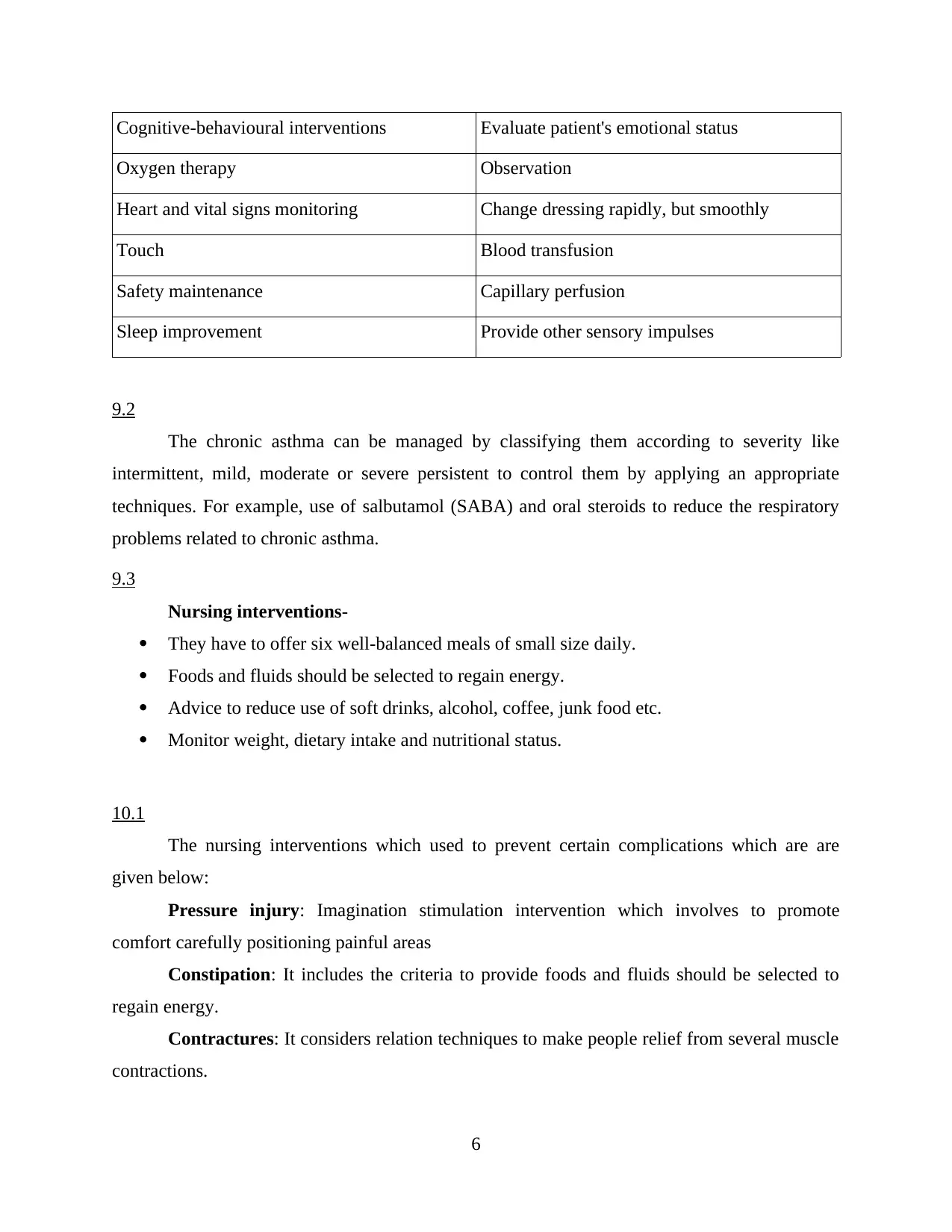
Cognitive-behavioural interventions Evaluate patient's emotional status
Oxygen therapy Observation
Heart and vital signs monitoring Change dressing rapidly, but smoothly
Touch Blood transfusion
Safety maintenance Capillary perfusion
Sleep improvement Provide other sensory impulses
9.2
The chronic asthma can be managed by classifying them according to severity like
intermittent, mild, moderate or severe persistent to control them by applying an appropriate
techniques. For example, use of salbutamol (SABA) and oral steroids to reduce the respiratory
problems related to chronic asthma.
9.3
Nursing interventions-
They have to offer six well-balanced meals of small size daily.
Foods and fluids should be selected to regain energy.
Advice to reduce use of soft drinks, alcohol, coffee, junk food etc.
Monitor weight, dietary intake and nutritional status.
10.1
The nursing interventions which used to prevent certain complications which are are
given below:
Pressure injury: Imagination stimulation intervention which involves to promote
comfort carefully positioning painful areas
Constipation: It includes the criteria to provide foods and fluids should be selected to
regain energy.
Contractures: It considers relation techniques to make people relief from several muscle
contractions.
6
Oxygen therapy Observation
Heart and vital signs monitoring Change dressing rapidly, but smoothly
Touch Blood transfusion
Safety maintenance Capillary perfusion
Sleep improvement Provide other sensory impulses
9.2
The chronic asthma can be managed by classifying them according to severity like
intermittent, mild, moderate or severe persistent to control them by applying an appropriate
techniques. For example, use of salbutamol (SABA) and oral steroids to reduce the respiratory
problems related to chronic asthma.
9.3
Nursing interventions-
They have to offer six well-balanced meals of small size daily.
Foods and fluids should be selected to regain energy.
Advice to reduce use of soft drinks, alcohol, coffee, junk food etc.
Monitor weight, dietary intake and nutritional status.
10.1
The nursing interventions which used to prevent certain complications which are are
given below:
Pressure injury: Imagination stimulation intervention which involves to promote
comfort carefully positioning painful areas
Constipation: It includes the criteria to provide foods and fluids should be selected to
regain energy.
Contractures: It considers relation techniques to make people relief from several muscle
contractions.
6
⊘ This is a preview!⊘
Do you want full access?
Subscribe today to unlock all pages.

Trusted by 1+ million students worldwide

Chest infection: It includes oxygen therapy when due to chest infection, an individual
face problem to breathe (Griffith, 2012).
11.1
Cognitive decline: This includes to solve present health concern along with recognising
and treating other co-morbidities as well. It is essential to take care of cognitive impairments
and manage them to sort out problems.
Sensory deficits: It involves frequent monitoring of client and maintaining their comfort
properly which helps to gain positive response from them.
12.1
The clinical hand overs or meetings are conducted due to some of very important purpose
then it is necessary to maintain records for future aspects. It includes the reason of taking care of
patient in proper manner while treating them to make them get rid of particular health issue.
Relevant documents or records helps to know actual status of person which help to conduct
treatment in correct way.
13.1
In case of Mr. Roy, due to providing treatment regime IV Benzyl penicillin infusion
which has several side effects such allergic reactions, pain, diarrhoea etc. Thus, it is necessary to
take several precautions while giving this dose like use it up to 30 ml per site otherwise it will
create problems same as facing by Mr. Roy.
13.2
As an enrolled nurse, I will give limited dosage while treating with IV Benzyl penicillin
infusion to avoid certain reactions. And in case of these effects which are faced by Mr. Roy. I
will suitable actions to reduce problem of rashes, itching, breathing by providing effective
treatment.
14.1
Deep breathing exercise: This can be done through breathe slowly by nose, expanding
rib cage and letting the abdomen move forward. Take complete breathing through pursed lips
and do not force breath out along with repeating this 10 times.
7
face problem to breathe (Griffith, 2012).
11.1
Cognitive decline: This includes to solve present health concern along with recognising
and treating other co-morbidities as well. It is essential to take care of cognitive impairments
and manage them to sort out problems.
Sensory deficits: It involves frequent monitoring of client and maintaining their comfort
properly which helps to gain positive response from them.
12.1
The clinical hand overs or meetings are conducted due to some of very important purpose
then it is necessary to maintain records for future aspects. It includes the reason of taking care of
patient in proper manner while treating them to make them get rid of particular health issue.
Relevant documents or records helps to know actual status of person which help to conduct
treatment in correct way.
13.1
In case of Mr. Roy, due to providing treatment regime IV Benzyl penicillin infusion
which has several side effects such allergic reactions, pain, diarrhoea etc. Thus, it is necessary to
take several precautions while giving this dose like use it up to 30 ml per site otherwise it will
create problems same as facing by Mr. Roy.
13.2
As an enrolled nurse, I will give limited dosage while treating with IV Benzyl penicillin
infusion to avoid certain reactions. And in case of these effects which are faced by Mr. Roy. I
will suitable actions to reduce problem of rashes, itching, breathing by providing effective
treatment.
14.1
Deep breathing exercise: This can be done through breathe slowly by nose, expanding
rib cage and letting the abdomen move forward. Take complete breathing through pursed lips
and do not force breath out along with repeating this 10 times.
7
Paraphrase This Document
Need a fresh take? Get an instant paraphrase of this document with our AI Paraphraser

Coughing exercise: Through supporting incision along with lying back with bending
knees and try to cough (Johnson and et. al., 2011).
14.2
Measures to maintain safety environment for patients are as follows:
Prevent central line-associated blood stream infections.
Limit shift durations for medical residents and other hospital staff if possible.
Measure the hospital's patient safety culture.
Consider several steps to ensure Patient Safety within an Organization.
15.1
Risk factors-
It may leads to several urinary infections.
It is risky procedure because it is applicable only people below age of 55 years.
15.2
Risk factors-
It may leads to dehydration in babies by gaining required electrolytes.
It also create certain issues like weight loss, dry mouth and sleepiness in baby.
15.3
Risk factors-
The delirium is already associated with adverse outcomes which make complex condition
of patient.
If patient will aged beyond 65 years then it will create major issues after abdominal
surgery.
15.4
Risk factors-
It may leads to permanent pain or swelling in leg.
In this problems, it may results into long term pain along with blood clot.
15.5
Risk factors-
It can be results into disc generation which facilitates into severe back pain.
It will creates problem of long term issue in walking and sitting.
8
knees and try to cough (Johnson and et. al., 2011).
14.2
Measures to maintain safety environment for patients are as follows:
Prevent central line-associated blood stream infections.
Limit shift durations for medical residents and other hospital staff if possible.
Measure the hospital's patient safety culture.
Consider several steps to ensure Patient Safety within an Organization.
15.1
Risk factors-
It may leads to several urinary infections.
It is risky procedure because it is applicable only people below age of 55 years.
15.2
Risk factors-
It may leads to dehydration in babies by gaining required electrolytes.
It also create certain issues like weight loss, dry mouth and sleepiness in baby.
15.3
Risk factors-
The delirium is already associated with adverse outcomes which make complex condition
of patient.
If patient will aged beyond 65 years then it will create major issues after abdominal
surgery.
15.4
Risk factors-
It may leads to permanent pain or swelling in leg.
In this problems, it may results into long term pain along with blood clot.
15.5
Risk factors-
It can be results into disc generation which facilitates into severe back pain.
It will creates problem of long term issue in walking and sitting.
8
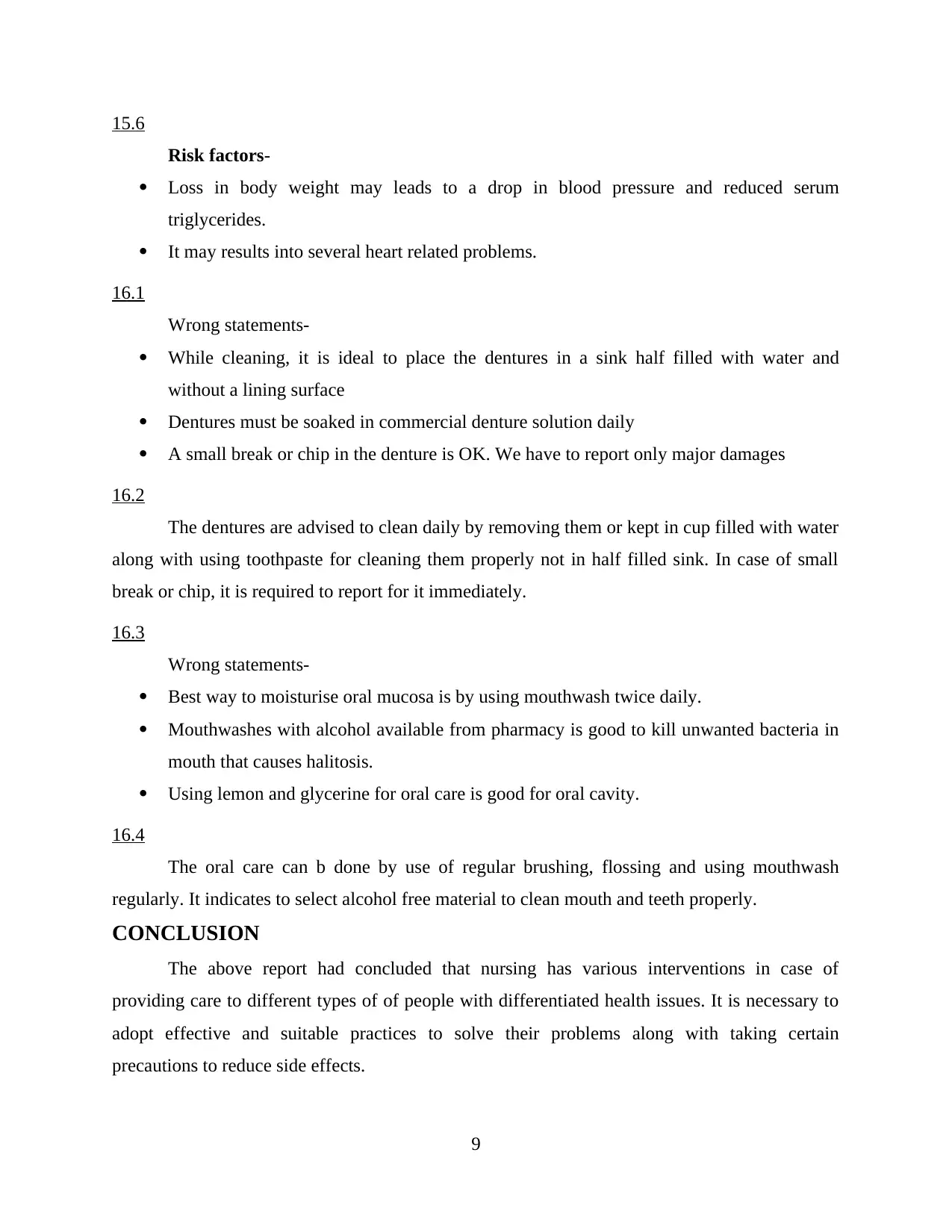
15.6
Risk factors-
Loss in body weight may leads to a drop in blood pressure and reduced serum
triglycerides.
It may results into several heart related problems.
16.1
Wrong statements-
While cleaning, it is ideal to place the dentures in a sink half filled with water and
without a lining surface
Dentures must be soaked in commercial denture solution daily
A small break or chip in the denture is OK. We have to report only major damages
16.2
The dentures are advised to clean daily by removing them or kept in cup filled with water
along with using toothpaste for cleaning them properly not in half filled sink. In case of small
break or chip, it is required to report for it immediately.
16.3
Wrong statements-
Best way to moisturise oral mucosa is by using mouthwash twice daily.
Mouthwashes with alcohol available from pharmacy is good to kill unwanted bacteria in
mouth that causes halitosis.
Using lemon and glycerine for oral care is good for oral cavity.
16.4
The oral care can b done by use of regular brushing, flossing and using mouthwash
regularly. It indicates to select alcohol free material to clean mouth and teeth properly.
CONCLUSION
The above report had concluded that nursing has various interventions in case of
providing care to different types of of people with differentiated health issues. It is necessary to
adopt effective and suitable practices to solve their problems along with taking certain
precautions to reduce side effects.
9
Risk factors-
Loss in body weight may leads to a drop in blood pressure and reduced serum
triglycerides.
It may results into several heart related problems.
16.1
Wrong statements-
While cleaning, it is ideal to place the dentures in a sink half filled with water and
without a lining surface
Dentures must be soaked in commercial denture solution daily
A small break or chip in the denture is OK. We have to report only major damages
16.2
The dentures are advised to clean daily by removing them or kept in cup filled with water
along with using toothpaste for cleaning them properly not in half filled sink. In case of small
break or chip, it is required to report for it immediately.
16.3
Wrong statements-
Best way to moisturise oral mucosa is by using mouthwash twice daily.
Mouthwashes with alcohol available from pharmacy is good to kill unwanted bacteria in
mouth that causes halitosis.
Using lemon and glycerine for oral care is good for oral cavity.
16.4
The oral care can b done by use of regular brushing, flossing and using mouthwash
regularly. It indicates to select alcohol free material to clean mouth and teeth properly.
CONCLUSION
The above report had concluded that nursing has various interventions in case of
providing care to different types of of people with differentiated health issues. It is necessary to
adopt effective and suitable practices to solve their problems along with taking certain
precautions to reduce side effects.
9
⊘ This is a preview!⊘
Do you want full access?
Subscribe today to unlock all pages.

Trusted by 1+ million students worldwide
1 out of 13
Related Documents
Your All-in-One AI-Powered Toolkit for Academic Success.
+13062052269
info@desklib.com
Available 24*7 on WhatsApp / Email
![[object Object]](/_next/static/media/star-bottom.7253800d.svg)
Unlock your academic potential
Copyright © 2020–2025 A2Z Services. All Rights Reserved. Developed and managed by ZUCOL.




